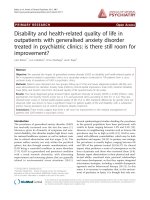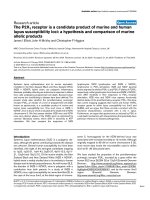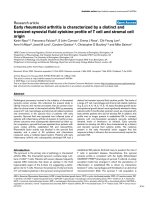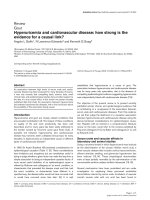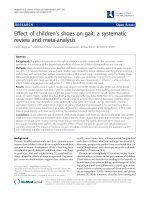Báo cáo y học: "Chiropractic and children: Is more research enoug" ppsx
Bạn đang xem bản rút gọn của tài liệu. Xem và tải ngay bản đầy đủ của tài liệu tại đây (340.59 KB, 5 trang )
Leboeuf-Yde and Hestbæk Chiropractic & Osteopathy 2010, 18:11
/>Open Access
COMMENTARY
© 2010 Leboeuf-Yde and Hestbæk; licensee BioMed Central Ltd. This is an Open Access article distributed under the terms of the Cre-
ative Commons Attribution License ( which permits unrestricted use, distribution, and re-
production in any medium, provided the original work is properly cited.
Commentary
Chiropractic and children: Is more research
enough?
Charlotte Leboeuf-Yde
1,2
and Lise Hestbæk*
3
Abstract
Many health science research and review articles end with the words: "More research is needed". However, when it
comes to research, it is not as much a question of quantity as of quality. There are a number of important prerequisites
before research should be initiated. The three pillars, relevance, quality and ethics should be respected but for a project
to be meaningful, it must also be based on plausible rationale.
In evidence-based (informed) practice, one takes into account not only research-based evidence but also clinical
expertise and the patients' perspectives. In this paper, we briefly discuss how this should be handled in clinical practice
is briefly discussed, using the concept of "traffic lights" (red, yellow, green). We explain how the combination of
evidence and plausibility can be used to reach a decision as to whether a treatment or diagnostic procedure is suitable,
possible, or unsuitable.
In this thematic series of Chiropractic & Osteopathy a number of reviews are presented, in which the research status of
pediatric chiropractic is scrutinized and found wanting. Two important aspects were studied in these reviews: the
effect of treatment and safety issues. Two types of problems were identified: the lack of research in general and the lack
of research using the appropriate study designs and methodology in particular. Therefore, we discuss the meager
research noted in the areas of chiropractic care in children and the clinical consequences this should have. The
prerequisites for "more research" are scrutinized and an example given of suitable research programs.
Finally, the important issue of implementation of research findings is covered, emphasizing the responsibility of all
stakeholders involved at both the undergraduate and the postgraduate level, within professional associations, and on
an individual level.
Introduction
Always more research?
Many health science research and review articles end
with the words: "More research is needed". However,
when is more research really needed? Obviously, research
should be relevant, of good quality and ethically defensi-
ble.
Discussion
When is research relevant?
Whether research is relevant or not is decided by the
researchers and by the funding bodies, who are willing to
pay for it. Relevance is often considered on the basis of
one or several of the following factors: the incidence/
prevalence of a problem, its seriousness/importance and
its associated costs or consequences.
When conducting health-related research on people,
there must also be an anatomical/physiological/biological
rationale. Sometimes there is a previous study indicating
the way to go, the clinical experience points in a certain
direction, or new information may challenge a previous
view. If none of these criteria are present, the study sub-
ject does not appear relevant.
When is research of good quality?
Providing that the study is considered relevant, how does
one then assure sufficient quality? The most important
aspect to the quality of research is to choose a study
design that is able to bring forth an answer to the research
question. For example, if you want to know if treatment A
"works" or not, it is necessary to compare treatment A
with treatment B or with no treatment at all and to do this
in a randomized controlled clinical trial (RCT). If your
* Correspondence:
3
Nordic Institute of Chiropractic and Clinical Biomechanics, Forskerparken 10,
DK-5230 Odense M, Denmark
Full list of author information is available at the end of the article
Leboeuf-Yde and Hestbæk Chiropractic & Osteopathy 2010, 18:11
/>Page 2 of 5
question is in relation to the cause of a disease, it is neces-
sary to compare people subjected to the suspected cause
with those not subjected to it. To investigate if a clinical
test is useful, it is necessary to be compare how the test
behaves in both diseased and non-diseased people and, if
possible, to compare its accuracy to a "gold standard" test.
Having selected the correct study design, it is thereafter
important to comply with a set of rules for the methods
used in the study. These rules differ depending on the
study design. There are a number of check-lists that can
be consulted and used when planning such studies [1-3].
If the researcher does not follow these rules, the data are
likely to be flawed and therefore the end result cannot be
trusted. For example, when studying the effect of treat-
ment, it would be necessary to randomly allocate study
subjects into different treatment groups and to investi-
gate the outcome without having the possibility of some-
thing other than the treatment to influence the results,
either on purpose or subconsciously. In the publication
process, a lot of importance is placed on the quality
aspect of the research and of the research report. The
quality control is taken care of during the peer-review,
providing that the peers who do the reviewing are suffi-
ciently knowledgeable and thorough to assume this task.
Unfortunately, some studies of poor quality are pub-
lished. Such publications can cause considerable damage,
as the uninformed reader could be fooled into believing
in the study results, regardless of whether they are credi-
ble or not.
When is research ethically defensible?
Ethics covers both care and respect for study subjects.
Everybody will surely agree that research should not be
harmful to study subjects. It may not be quite so obvious
that it is also unethical to conduct irrelevant studies or
studies of poor quality. If the study turns out to be super-
fluous, if the study design is such t hat it cannot bring an
answer to the research question, or if the method is such
that the answers are not trustable, the study is unethical.
In more detail, these reasons are as follows: 1) it is not fair
to inconvenience study subjects with studies of no conse-
quence, 2) poor quality studies draw limited research
funds away from studies of higher quality, and, very
importantly, 3) if published they can mislead clinicians
who trust in research and believe in what they read.
What can research be used for in clinical practice? The three
legs of evidence-based practice
The essence of the decision making process for responsi-
ble patient care in evidence-based practice is that it relies
on the integration of 1) clinical expertise,2) patient per-
spectives, and 3) the best evidence (i.e. research findings)
[4]. However, it is important to keep a humble attitude to
one's own clinical experience and not to think that it
overrides the evidence obtained in a good quality RCT.
Also, one or even several persons' clinical experience is
not synonymous with clinical expertise.
When are we "allowed" to treat our patients?
In chiropractic practice, if there is high quality research
evidence in favor of a clinical treatment, this constitutes a
green light for action.
If there is no research evidence, the first two legs of the
evidence-based model, experience and the patient per-
spectives, may still justify treatment. This corresponds to
the yellow light, where one can proceed with caution
under certain circumstances. Obviously, it would not be
suitable to claim to be able to treat untested conditions.
But if approached by a patient who would like to try such
a treatment, it may be acceptable to provide a trial of
treatment, providing that the treatment is safe, and that
the attempt is interrupted if no obvious changes occur
within a brief period of time.
However, if the treatment lacks anatomical/physiologi-
cal/biological plausibility, treatment is never acceptable.
The same is the case, if there is evidence working against
a treatment. These are to be considered obvious red
lights.
Which diagnostic tests can we trust?
Any treatment depends on the diagnosis. Evidence that a
diagnostic procedure or system actually helps separate
the sick from the healthy or that it makes a difference in
relation to treatment outcome, turns the diagnostic pro-
cedure into a green light-procedure; one that can be used
with good confidence.
Unfortunately only few diagnostic tests relevant to chi-
ropractic practice have been tested or tested properly. If
the test is biologically plausible but untested, it corre-
sponds to a yellow light and should not be used as the sole
rationale for treatment. However, it can be used in con-
junction with other plausible information to help form an
overall opinion of the case.
If the test is neither biologically implausible nor vali-
dated, it corresponds to a red light situation and should
not be used.
Chiropractic care and children
Over the past years there has been some controversy
about whether chiropractors can treat children or not.
The question appears nonsensical. Why should chiro-
practors not be able to treat children? Obviously the
scope of complaints will differ somewhat for different age
groups, and the management strategy including choice of
treatment methods will have to be adapted to the individ-
ual, but this is not specific to children. This argument
seems to be supported by the fact that when children are
treated by chiropractors the way adults are treated in chi-
ropractic practice (i.e. mainly for musculoskeletal disor-
Leboeuf-Yde and Hestbæk Chiropractic & Osteopathy 2010, 18:11
/>Page 3 of 5
ders and for the occasional "other" condition), no such
controversy appears to exist.
Rather, the source of the controversy seems to be vari-
ous claims of miracle cures of "other" conditions, such
asthma, enuresis, otitis media, colic, and attention defi-
cit/hyperactivity disorder. Such information sometimes
appears on chiropractors' homepages or at seminars,
often masked as evidence-based fact. When such claims
are ill-founded, as the reviews in this theme series of Chi-
ropractic & Osteopathy show them to be, it is not surpris-
ing that they cause ill-feelings.
Whenever there is controversy as to whether a treat-
ment is suitable or not, we should turn toward the
research literature to find the hard evidence available.
Anecdotes, case studies, ideology, feelings and subjective
arguments do not form a sufficient basis on which treat-
ment can be based.
Present level of research evidence
In this theme series of Chiropractic & Osteopathy a num-
ber of reviews are presented, in which the research status
of pediatric chiropractic is scrutinized and found want-
ing. Two important aspects were studied in these reviews:
the effect of treatment and safety issues. The conclusions
can be summarized in this one sentence. Two types of
problems were identified: the lack of research in general
and the lack of research using the appropriate study
designs and methodology in particular.
Positive effect of treatment
Generally, the reviews tell the same story in relation to
effect of treatment of children regardless the area that
was under review: absence of suitable well designed RCTs
and, at best, conflicting evidence. However, absence of
evidence of effect is not the same as evidence of absence
of effect [5] and this absence of facts is not unique to chi-
ropractic. Due to limited resources, both in terms of
finances and manpower, most treatments of the various
conditions in childhood are still scientifically untested.
However, this is not generally considered a large problem,
as long as the treatment is based on generally accepted
basic science knowledge and logical treatment models.
Adverse effects
Any treatment for a disorder can be expected to have a) a
positive effect b) no effect, or c) an adverse effect, or a
combination of these. When studying positive treatment
effects, the only generally accepted study design is that of
an RCT. In the absence of an untreated control group,
one can only observe outcome, which may or may not be
caused by the therapy provided.
Interestingly, when studying adverse effects of spinal
manipulation, simple case-reports or series of case-
reports are apparently considered sufficient to prove
effect (in this case: adverse effects) of treatment. In other
words, studies with an improper design appear to have
been considered acceptable and the mere presence of
temporality (treatment occurred before the adverse
event) has been used as evidence of cause-effect.
Severe complications after spinal manipulations are
rare [6,7] and therefore unsuitable for study in an RCT,
because such a study would have to contain millions of
patients before firm conclusions could be drawn as to
whether specific complications could be the product of
spinal manipulation. Other more tricky designs, such as
case-control studies, preferably from large population-
based registers will have to be used instead. Given the rel-
atively small number of children treated in chiropractic
practice and the difficulty in conducting such studies, it is
unlikely that in the short term we will obtain such infor-
mation on the pediatric population.
However, according to Humphreys [7], over the past 50
years or so, only 54 cases of adverse reactions have been
recorded after chiropractic care in patients under the age
of 18, and most of these were not serious in nature or not
directly related to the treatment. This area, therefore,
does not seem to be of highest research priority, as it does
not fulfill any of the relevance criteria (common, severe,
costly). Setting a large research program en route would
be a bit like sailing out in an armada looking for the Loch
Ness monster. This, of course, does not free the chiro-
practic practitioner from the duty to ensure that all treat-
ments, also of children, are provided only on clear
indications ("Is it logical?", "Has it been shown to work?").
In addition, in the case of trial treatments, it is important
to terminate the treatment if no clinically detectable
results are obtained. In fact, treatments without a plausi-
ble rationale should never be given, because the possibil-
ity of an unsuitable reaction is always possible.
"More research is needed"
As our resources are limited, it is necessary to consider
carefully what research it we need more of. Common,
severe and/or costly conditions with a plausible scientific
rationale should of course be highest on the list of priori-
ties. Back pain seems to be an obviously relevant research
area, as it is a condition that starts early in life [8], and
once there, has a strong tendency to recur later in life [9].
It is costly [10] and, for some people, although not life-
threatening, can have considerable consequences for
some [11]. The causes of back pain or non-recovery from
back pain are not well understood, and it is a condition
commonly treated by chiropractors [12,13]. RCTs have
shown that spinal manipulation in patients with back
pain in some cases will have an effect [14]. There are sev-
eral plausible proposed explanations for why this could
happen [15,16]. In sum, back pain is a good example of a
suitable topic for a research program in children. Such a
program is described in Appendix 1.
Leboeuf-Yde and Hestbæk Chiropractic & Osteopathy 2010, 18:11
/>Page 4 of 5
From the large array of research topics proposed in
Appendix 1, it becomes clear that data should be col-
lected in many different ways, such as through epidemio-
logic studies, various registers, in everyday practice and
through laboratory experiments. Data can also be col-
lected by asking questions, observing, and using
advanced technology. Importantly, the research design
should match the research question and the conclusion
should not exceed the result.
In order to set up a research program on chiropractic
treatment of "other" conditions in children, similar crite-
ria for relevance may be more difficult to fulfill, particu-
larly that of plausibility. Also, it would be necessary to
consider why this condition should be studied only in
childhood, as it is unclear whether there is some age-limit
beyond which chiropractic care of these conditions no
longer has an effect. For example, some plausible reason
why ADHD can be treated in children but not in adults
should be stated.
Fewer case-reports are needed
When calling for more research, it must be understood
that this excludes case-reports. Case-reports are usually
easy to read, bring mainly clinical elements into the pic-
ture, tell an unusual story, are often accompanied by pho-
tographs, and seem to be very attractive to clinicians.
However, they are rarely representative of what typically
happens in clinical practice.
Further, when they describe a positive outcome, this
cannot be interpreted as proof of treatment effect for, at
least, the following reasons: First, improvement after
treatment may not be causally linked to the treatment; it
could have happened anyway. Second, one treated case
may well have improved with treatment but, because
none of the other similar patients who did not recover
were described, the relative importance of this phenome-
non cannot be estimated. Third, because case-reports are
often retrospective, data collection was not geared
towards accurate recording. For the same reason, there
would have been no quality control of the examination,
treatment, or write-up. Fourth, the outcome would have
been reported directly to the clinician, and both patient
and clinician would have been willing to see a positive
effect, thus the outcome measurement would be subjec-
tive. In fact, case-reports have about the same draw-backs
as the experience clinicians have in their own clinic.
Therefore, the research community, health care planners
and policy makers are not impressed when case-reports
are used as "evidence" of effect of treatment because this
type of "evidence" cannot result in any general conclusions
or recommendations. And, for the same reason, clinicians
should be weary of their own observations.
Implementation of research findings
More research is always needed. However, research on its
own cannot transform a clinical profession. In the case of
pediatrics, we can see at least three barriers to implemen-
tation.
First, there is a lot of respect for research. It is therefore
not surprising that when chiropractors consult research
articles they will often believe what they read, even if the
research lacks credibility. Presently, most chiropractic
pediatric research literature lacks credibility. When edi-
tors of second-rate scientific publications and some lec-
turers at professional seminars pretend to provide an
evidence-based treatment model, clinicians may not real-
ize that the new treatment method is, in fact, largely
imagination-based.
Second, most clinicians, including chiropractors, have
little time to read research papers, and if they do, they are
often uncertain of the quality of the research. Therefore,
they probably often rely on other external sources such as
hearsay, information obtained at seminars, and simple
professional texts such as case-reports. If this informa-
tion is grossly incorrect, they will practice imagination-
based chiropractic but in good faith.
Third, clinicians, who practice in a lucid mainstream
manner, may change approach in relation to children,
because sick children are vulnerable, parents demand
treatment and expect cure, and it is difficult to ignore a
suffering child. They may therefore seek to help at all
costs, perhaps forgetting that most of these "other" condi-
tions are self-limited or transitory. However, it is not in
good taste to play on the vulnerability of others who are
easy victims of bogus claims. This is true, whether the
victims are clinicians attending a seminar or patients
seeking care.
With more relevant and high quality research, with bet-
ter and more user-friendly information to clinicians, and
with more vigilance from the lecturers in undergraduate
programs, presenters at professional seminars, and pro-
fessional associations, it should be possible to provide
patients of all ages with relevant and effective treatment
also when they attend a chiropractor's office. Neverthe-
less, the final responsibility is still in hands of the individ-
ual practitioner.
Conclusion
We believe that the answer to the question proposed in
the title "Is more research enough?" is "No". We must not
be satisfied with quantity but strive towards high stan-
dards of quality of the published research and work
harder at all levels on implementing research into prac-
tice.
Leboeuf-Yde and Hestbæk Chiropractic & Osteopathy 2010, 18:11
/>Page 5 of 5
Appendix 1. Example of three research programs
on back pain in children
1. The course and character of back pain:
• Onset/continuation/development, symptoms of spi-
nal pain from the early years.
• Development over age for various spinal disorders
• The association between early spinal degeneration
and spinal pain
• Normal and abnormal pain patterns of symptoms
2. Causes of back pain
• The respective roles of genetic and extrinsic factors in
both onset and continuation of back pain
• The anatomical and neurophysiological mechanisms
for the maintenance of and the recovery from spinal
symptoms
• The role of intrinsic and extrinsic biomechanical fac-
tors in both onset, continuation and termination of back
pain
3. Treatment of back pain
• Treatment response of different treatment methods
• Treatment response at different ages
Authors' contributions
CL conceived of the study and made the first draft. Both authors contributed to
the manuscript and approved the final manuscript.
Author Details
1
Spinecenter of Southern Denmark, Hospital Lillebaelt, Østre Hougvej 55, DK-
5500 Middelfart, Denmark,
2
Institut Franco-Europeen de Chiropratique, 24,
Boulevard Paul Vaillant Couturier, F-94200 Ivry-sur-Seine, France and
3
Nordic
Institute of Chiropractic and Clinical Biomechanics, Forskerparken 10, DK-5230
Odense M, Denmark
References
1. Schulz KF, Altman DG, Moher D, Group C: CONSORT 2010 Statement:
updated guidelines for reporting parallel group randomised trials.
BMC Med 2010, 8:18.
2. Von EE, Altman DG, Egger M, Pocock SJ, Gotzsche PC, Vandenbroucke JP:
The Strengthening the Reporting of Observational Studies in
Epidemiology (STROBE) statement: guidelines for reporting
observational studies. Lancet 2007, 370:1453-1457.
3. Cook C, Cleland J, Huijbregts P: Creation and Critique of Studies of
Diagnostic Accuracy: Use of the STARD and QUADAS Methodological
Quality Assessment Tools. J Man Manip Ther 2007, 15:93-102.
4. Sackett D: Evidence-based Medicine: How to Practice and Teach EBM.
2nd edition. New York: Churchill Livingstone; 2000.
5. Altman DG, Bland JM: Absence of evidence is not evidence of absence.
BMJ 1995, 311:485.
6. Assendelft WJ, Bouter LM, Knipschild PG: Complications of spinal
manipulation: a comprehensive review of the literature. J Fam Pract
1996, 42:475-480.
7. Humphreys BK: Possible adverse events in children treated by manual
therapy: a review. Chiropr Osteopat 2010, 18:12.
8. Leboeuf-Yde C, Kyvik KO: At what age does low back pain become a
common problem? A study of 29,424 individuals aged 12-41 years.
Spine (Phila Pa 1976) 1998, 23:228-234.
9. Hestbaek L, Leboeuf-Yde C, Kyvik KO, Manniche C: The course of low back
pain from adolescence to adulthood: eight-year follow-up of 9600
twins. Spine (Phila Pa 1976) 2006, 31:468-472.
10. Martin BI, Turner JA, Mirza SK, Lee MJ, Comstock BA, Deyo RA: Trends in
health care expenditures, utilization, and health status among US
adults with spine problems, 1997-2006. Spine (Phila Pa 1976) 2009,
34:2077-2084.
11. Hartvigsen J, Nielsen J, Kyvik KO, Fejer R, Vach W, Iachine I, Leboeuf-Yde C:
Heritability of spinal pain and consequences of spinal pain: a
comprehensive genetic epidemiologic analysis using a population-
based sample of 15,328 twins ages 20-71 years. Arthritis Rheum 2009,
61:1343-1351.
12. Sorensen LP, Stochkendahl MJ, Hartvigsen J, Nilsson NG: Chiropractic
patients in Denmark 2002: an expanded description and comparison
with 1999 survey. J Manipulative Physiol Ther 2006, 29:419-424.
13. Rubinstein S, Pfeifle CE, van Tulder MW, Assendelft WJ: Chiropractic
patients in the Netherlands: a descriptive study. J Manipulative Physiol
Ther 2000, 23:557-563.
14. Bronfort G, Haas M, Evans R, Leininger B, Triano J: Effectiveness of manual
therapies: the UK evidence report. Chiropr Osteopat 2010, 18:3.
15. Cox J: Low back pain. Mechanism, diagnosis and treatment. Volume
Chapter 2. 6th edition. Baltimore: Williams and Wilkins; 1999.
16. Plaugher Ge: Textbook of clinical chiropractic. A specific biomechanical
approach. Volume Chapter 3. Baltimore: Williams & Wilkins; 1993.
doi: 10.1186/1746-1340-18-11
Cite this article as: Leboeuf-Yde and Hestbæk, Chiropractic and children: Is
more research enough? Chiropractic & Osteopathy 2010, 18:11
Received: 10 April 2010 Accepted: 2 June 2010
Published: 2 June 2010
This article is available from: 2010 Leboeuf-Yde and Hestbæk; licensee BioMed Central Ltd. This is an Open Access article distributed under the terms of the Creative Commons Attribution License ( ), which permits unrestricted use, distribution, and reproduction in any medium, provided the original work is properly cited.Chiropractic & Osteopathy 2010, 18:11

